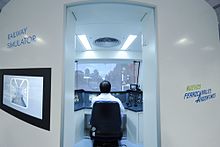Train simulator
This article has multiple issues. Please help improve it or discuss these issues on the talk page. (Learn how and when to remove these template messages)
|
 |
| Part of a series on |
| Simulation video games |
|---|
A train simulator (also railroad simulator or railway simulator) is a computer based simulation of rail transport operations. They are generally large complicated software packages modeling a 3D virtual reality world, with 'play mode' software which lets the user interact by stepping inside the virtual world. Some, like the first Microsoft Train Simulator are written and modeled for the user mainly interested in driving.
Industrial train simulations

Like flight simulators, train simulators have been produced for railway training purposes. Driver simulators include those produced by:
- Ongakukan in Japan[1]
- EADS in Germany[2]
- Bentley Systems in the UK[3]
- Lander Simulation & Training Solutions, Spain [4]
- Transurb Technirail, a Belgian company based in Brussels
- CORYS T.E.S.S., a French company based in Grenoble
- Krauss-Maffei Wegmann GmbH & Co KG (KMW) http://www.kmweg.de/, a German company based in Munich
- Sydac a member of the Knorr-Bremse Group based in Australia.
- OKTAL, a French company member of the international group SOGECLAIR based in Toulouse
- New York Air Brake, an American company based in Watertown, NY.[5]
- PS Technology, an American company based in Boulder, CO.[6]
Signaller training simulators have been developed by Funkwerk in Germany,[7][8] The Railway Engineering Company (TRE) in the UK,[9][10] OpenTrack Railway Technology in Switzerland,[11][12] and PS Technology in the US.[13]
Consumer train simulation
There are two broad categories of train simulation video games: driving simulation and strategy simulation.
Driving simulation
Train driving simulation games usually allow a user to have a "driver's view" from the locomotive's cab and operate realistic cab controls such as throttle, brake valve, sand, horn and whistle, lights etc.
One of the first commercially available train simulators was Southern Belle, released in 1985. The game simulated a journey of the Southern Belle steam passenger train from London Victoria to Brighton, while at the same time the player must comply with speed limits, not to go too fast on curves and keep to the schedule. It was followed with Evening Star in 1987.
Other train driving simulation software includes:
- BVE Trainsim (originally Boso View Express[14][15][16]) is a Japanese three-dimensional computer-based train simulator.[16] It is notable for focusing on providing an accurate driving experience[16][17][18] as viewed from inside the cab, rather than creating a network of other trains—There are no outside views, drivers can only look directly ahead, and other trains passed along the route are only displayed as stationary objects.[16][19][20]
- openBVE, an open source derivative of BVE Trainsim, which although developed from scratch expands upon the capabilities of BVE by including support for train exteriors, animated 3D cab environments and animated scenery.[21]
- Trainz, an extensively expandable and user extendable (by scripts) simulator with intuitive GUI world modeling and asset creation facilities, an extensive freeware library of over 250,000 assets, and an attention to Train physics. The simulator offers 4 viewing modes, and for beginning drivers or learning a route, a control mode similar to that of a H.O. scale model train set.
- Densha de Go!, a Japanese (only) train simulation game series focused on driving.
- Microsoft Train Simulator (MSTS), with limited route building and difficult expansion capabilities.
- Open Rails, a free software alternative to MSTS which is functionally equivalent but uses current technology and has an active development programme.[22]
- Rail Simulator, another extensively expandable and user orientated creation simulator with intuitive driving modes and editing tools. The main focus is on driving a train from the cab while performing a series of pre-determined tasks. Additional modes allow differing levels of control and interaction. Built by the company behind the original Microsoft Train Simulator software, and published by Electronic Arts.
- Train Simulator (originally RailWorks), successor to Rail Simulator, the software was subject to a management buy out. Operating as Rail Simulator Developments Ltd, the software was rebranded, improved and adapted for the Steam online distribution system. Expanding on the capabilities of the original version, RailWorks went on to develop the concept of Downloadable Content (DLC) addons providing users with optional additional purchases. While the majority of DLC is sold as payware through Steam, many of the Microsoft Train Simulator developers also provide routes, trains and scenarios as freeware and payware. The software entered its current incarnation in 2012 when the company behind its development rebranded as Dovetail Games, and put the simulator through a similar program of reinvention. Continuing to be sold primarily though Steam, boxed versions are released annually each September, incrementing the title (TS2013 / TS2014 / TS2015). Each annual release encompasses a range of global enhancements that are distributed free to all users, and a range of purchasable routes and trains that make use of the new features as a demo to prospective customers.
- Train Simulator series (a.k.a. Railfan)
- Run 8, a standalone simulator with the goal to have as realistic physical properties of train handling as possible.
The PC game 3D Ultra Lionel Traintown, amongst some others, give a different experience to driving, by being in a 3rd person omniscient perspective, controlling the trains from a bird's eye view.
Peripherals specifically designed for use with driving simulations include RailDriver by US manufacturer P.I. Engineering. RailDriver is a programmable desktop cab controller with throttle, brake lever and switches designed to work with Trainz, TrainMaster, Microsoft Train Simulator and Rail Simulator.[23]
Strategy simulation
Railroad-themed strategy simulation video games are focused mostly on the economic part of the railroad industry rather than on technical detail. The A-Train series (1985 to present) is an early example. Chris Sawyer's Transport Tycoon (1994) was an influential game in this genre,[24] spawning remakes such as Simutrans (1999 to present), OpenTTD (2004 to present) and Sawyer's own Locomotion (2004). Sid Meier designed two railroad simulations: Railroad Tycoon (1990) and Railroads! (2006). The Railroad Tycoon series itself inspired other rail games such as Rails Across America (2001).[25]
Some rail simulation games focus on railroad switches rather than economics. Examples include The Train Game (1983) and SimSig (donationware). JBSS BAHN (shareware) focuses on simulating a complex railroad lay out.
See also
- Flight simulator – contains reference to flight simulators
- Strategy computer game
References
- ^ "Train Simulator for Pro-use" in Ongakukan website. Retrieved 2010-03-26.
- ^ "EADS - Very High Speed, Intercity and Suburban Train Simulators". railway-technology.com. SPG Media Limited. Retrieved 2009-03-14.
- ^ "First Great Western - Investment in driver training with new lifesize simulator". www.firstgreatwestern.co.uk. 4 March 2004. Retrieved 2009-03-14.
- ^ "LANDER Simulation & Training Solutions - Training Simulators - Railway Technology". www.railway-technology.com. Retrieved 2009-01-24.
- ^ http://www.nyab.com/en/products/simulators/tds5000/tds5000_1.jsp
- ^ http://www.pstechnology.com/locomotive-simulation
- ^ "BEST –Trainingssystem für die Ausbildung des Personals in Leitzentralen und Stellwerken" (in German). Retrieved 2013-03-19.
- ^ "SBB: Moderne Simulatoren für Zugverkehrsleiter" (in German). eurailpresse.de. 15 September 2009. Retrieved 2013-03-19.
- ^ Ryland, H (November 10–11, 2005). "Operations - the value of training simulators [railway signaller training]". Safety Assurance, 2005. The IEE Seminar on (Ref. No. 2005/11081). The Institute of Electrical and Electronics Engineers. ISSN 0537-9989. Retrieved 2009-03-14.
Since the Cullen Report into the accident at Ladbroke Grove, there has been increased pressure to improve the training of railway signallers. The Railway Engineering Company has responded to this situation by providing comprehensive signaller training systems. These have been installed for all workstations at all the IECC installations on Network Rail.
- ^ "TRE_CORPORATE_BROCHURE.pdf (application/pdf Object)" (PDF). www.theraileng.co.uk. Retrieved 2009-01-24.
- ^ Hürlimann, Daniel (20 September 2007). "OpenTrack presentation" (PDF). The 12th Conference of the railML Initiative (in German). RailML.org. Retrieved 2009-03-14.
- ^ "OpenTrack Railway Technology - Railway Simulation". www.opentrack.ch. Retrieved 2009-01-24.
- ^ http://www.pstechnology.com/conductor-training
- ^ Lew, Alexander (2007-12-17). "The Best Free Train Simulator". Autopia. Wired News. Archived from the original on 4 May 2009. Retrieved 2009-05-04.
{{cite news}}: Italic or bold markup not allowed in:|publisher=(help); Unknown parameter|deadurl=ignored (|url-status=suggested) (help) - ^ BVE Train Simulator(archive), The Simon Tonekham Statesman blog
- ^ a b c d "Announcing Boso View Express (BVE)". Train Simmer. 2001-02-26. Retrieved 2009-08-14.
Boso View Express (BVE) is a freeware 3D train simulator ... under development since 1996. ... nor does it offer dynamic scenery (moving trains). It does feature ... trains that react accurately
- ^ "Microsoft Train Simulator". CBS Interactive. 2005-01-03. Retrieved 2009-08-14.
BVE ... physics are comparable with the real trains. ... Plenty of routes and trains are available free too!
- ^ Baum, Peter. "Mechanik/ BVE". Retrieved 2009-08-14.
the trains actually rock back and forth and lean into turns ... has still remained popular due to its superior sound, train handling characteristics, and its easily modifiable components.
- ^ Barten, Alfred (2005). "Virtual Railroading/Train Simulation FAQs". Retrieved 2009.
BVE is built linearly. There is no opportunity to branch, unless the branched version is treated as a second route. ... BVE routes can also be built using Notepad
{{cite web}}: Check date values in:|accessdate=(help) - ^ Hanstater, David. "Editorial: BVE Train Simulator". Atomic Systems IP. Retrieved 2009-08-14.
BVE is much smaller ... the only view is straight forward through the cab window. There are no outside views
- ^ http://www.rockpapershotgun.com/2009/03/22/openbve-the-sim-now-approaching-platform-pc/. Rock, Paper, Shotgun. March 22, 2009. Retrieved July 14, 2013.
- ^ http://www.attherailyard.com/seasonfiveepisodes.htm At The Railyard. Sep 25 2013. Retrieved Jan 9, 2014.
- ^ "Train-Sim.Com Review: RailDriver". www.train-sim.com. Retrieved 2009-01-17.
- ^ Daniel Emery (10 March 2009). "Inside Games: Creative Assembly". BBC News. Retrieved 2009-11-09.
- ^ Scott Osborne (October 12, 2001). "Rails Across America Review". GameSpot. Retrieved 2009-11-09.
While admittedly inspired by the hit Railroad Tycoon series, Rails Across America takes a broader approach to rail empire building and offers some novel, entertaining features.
External links
- 2TRAIN Benchmarking Report on computer-based Railway Training in Europe
- RailServe.com (Directory of train simulator sites)
- Train simulator at Curlie
- Railpage Train Simulator Support Forums(Online Support Forum and Add-on downloads)
- VR Reading Room: Hundreds of articles covering all train simulators
- Train Simulation
- Metro Simulation
